Liang Liao
SDM-Car: A Dataset for Small and Dim Moving Vehicles Detection in Satellite Videos
Dec 24, 2024



Abstract:Vehicle detection and tracking in satellite video is essential in remote sensing (RS) applications. However, upon the statistical analysis of existing datasets, we find that the dim vehicles with low radiation intensity and limited contrast against the background are rarely annotated, which leads to the poor effect of existing approaches in detecting moving vehicles under low radiation conditions. In this paper, we address the challenge by building a \textbf{S}mall and \textbf{D}im \textbf{M}oving Cars (SDM-Car) dataset with a multitude of annotations for dim vehicles in satellite videos, which is collected by the Luojia 3-01 satellite and comprises 99 high-quality videos. Furthermore, we propose a method based on image enhancement and attention mechanisms to improve the detection accuracy of dim vehicles, serving as a benchmark for evaluating the dataset. Finally, we assess the performance of several representative methods on SDM-Car and present insightful findings. The dataset is openly available at https://github.com/TanedaM/SDM-Car.
Hyperspectral Image Spectral-Spatial Feature Extraction via Tensor Principal Component Analysis
Dec 08, 2024

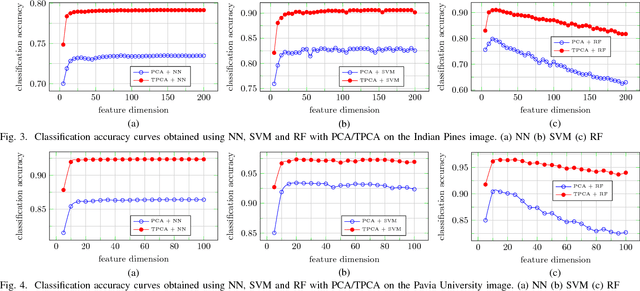

Abstract:This paper addresses the challenge of spectral-spatial feature extraction for hyperspectral image classification by introducing a novel tensor-based framework. The proposed approach incorporates circular convolution into a tensor structure to effectively capture and integrate both spectral and spatial information. Building upon this framework, the traditional Principal Component Analysis (PCA) technique is extended to its tensor-based counterpart, referred to as Tensor Principal Component Analysis (TPCA). The proposed TPCA method leverages the inherent multi-dimensional structure of hyperspectral data, thereby enabling more effective feature representation. Experimental results on benchmark hyperspectral datasets demonstrate that classification models using TPCA features consistently outperform those using traditional PCA and other state-of-the-art techniques. These findings highlight the potential of the tensor-based framework in advancing hyperspectral image analysis.
Towards Robust Online Domain Adaptive Semantic Segmentation under Adverse Weather Conditions
Sep 02, 2024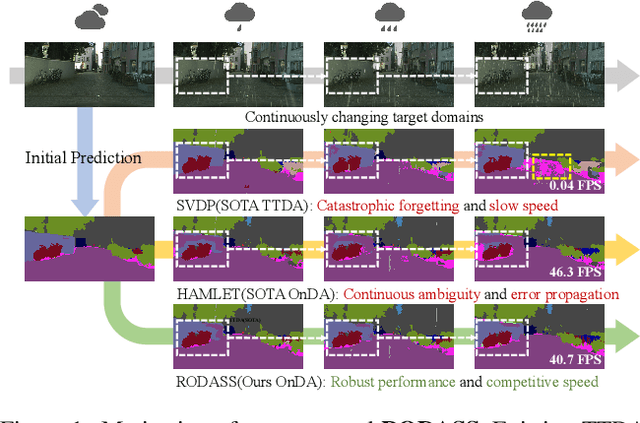

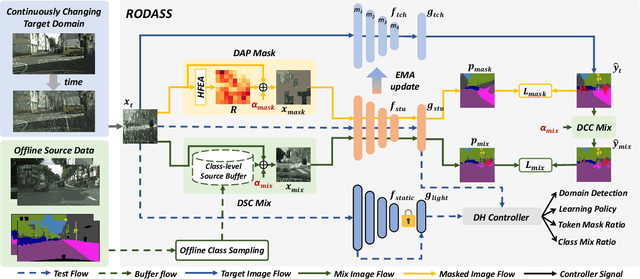

Abstract:Online Domain Adaptation (OnDA) is designed to handle unforeseeable domain changes at minimal cost that occur during the deployment of the model, lacking clear boundaries between the domain, such as sudden weather events. However, existing OnDA methods that rely solely on the model itself to adapt to the current domain often misidentify ambiguous classes amidst continuous domain shifts and pass on this erroneous knowledge to the next domain. To tackle this, we propose \textbf{RODASS}, a \textbf{R}obust \textbf{O}nline \textbf{D}omain \textbf{A}daptive \textbf{S}emantic \textbf{S}egmentation framework, which dynamically detects domain shifts and adjusts hyper-parameters to minimize training costs and error propagation. Specifically, we introduce the \textbf{D}ynamic \textbf{A}mbiguous \textbf{P}atch \textbf{Mask} (\textbf{DAP Mask}) strategy, which dynamically selects highly disturbed regions and masks these regions, mitigating error accumulation in ambiguous classes and enhancing the model's robustness against external noise in dynamic natural environments. Additionally, we present the \textbf{D}ynamic \textbf{S}ource \textbf{C}lass \textbf{Mix} (\textbf{DSC Mix}), a domain-aware mix method that augments target domain scenes with class-level source buffers, reducing the high uncertainty and noisy labels, thereby accelerating adaptation and offering a more efficient solution for online domain adaptation. Our approach outperforms state-of-the-art methods on widely used OnDA benchmarks while maintaining approximately 40 frames per second (FPS).
Q-Ground: Image Quality Grounding with Large Multi-modality Models
Jul 24, 2024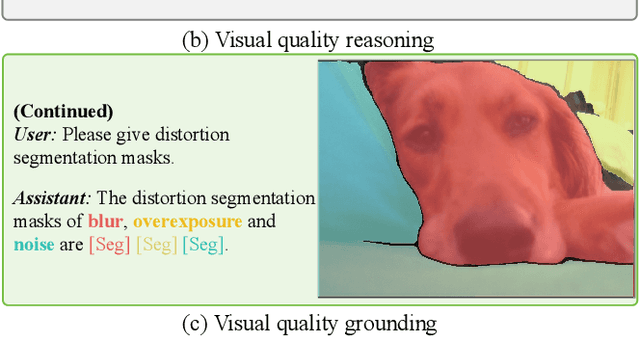



Abstract:Recent advances of large multi-modality models (LMM) have greatly improved the ability of image quality assessment (IQA) method to evaluate and explain the quality of visual content. However, these advancements are mostly focused on overall quality assessment, and the detailed examination of local quality, which is crucial for comprehensive visual understanding, is still largely unexplored. In this work, we introduce Q-Ground, the first framework aimed at tackling fine-scale visual quality grounding by combining large multi-modality models with detailed visual quality analysis. Central to our contribution is the introduction of the QGround-100K dataset, a novel resource containing 100k triplets of (image, quality text, distortion segmentation) to facilitate deep investigations into visual quality. The dataset comprises two parts: one with human-labeled annotations for accurate quality assessment, and another labeled automatically by LMMs such as GPT4V, which helps improve the robustness of model training while also reducing the costs of data collection. With the QGround-100K dataset, we propose a LMM-based method equipped with multi-scale feature learning to learn models capable of performing both image quality answering and distortion segmentation based on text prompts. This dual-capability approach not only refines the model's understanding of region-aware image quality but also enables it to interactively respond to complex, text-based queries about image quality and specific distortions. Q-Ground takes a step towards sophisticated visual quality analysis in a finer scale, establishing a new benchmark for future research in the area. Codes and dataset are available at https://github.com/Q-Future/Q-Ground.
360VFI: A Dataset and Benchmark for Omnidirectional Video Frame Interpolation
Jul 19, 2024



Abstract:With the development of VR-related techniques, viewers can enjoy a realistic and immersive experience through a head-mounted display, while omnidirectional video with a low frame rate can lead to user dizziness. However, the prevailing plane frame interpolation methodologies are unsuitable for Omnidirectional Video Interpolation, chiefly due to the lack of models tailored to such videos with strong distortion, compounded by the scarcity of valuable datasets for Omnidirectional Video Frame Interpolation. In this paper, we introduce the benchmark dataset, 360VFI, for Omnidirectional Video Frame Interpolation. We present a practical implementation that introduces a distortion prior from omnidirectional video into the network to modulate distortions. We especially propose a pyramid distortion-sensitive feature extractor that uses the unique characteristics of equirectangular projection (ERP) format as prior information. Moreover, we devise a decoder that uses an affine transformation to facilitate the synthesis of intermediate frames further. 360VFI is the first dataset and benchmark that explores the challenge of Omnidirectional Video Frame Interpolation. Through our benchmark analysis, we presented four different distortion conditions scenes in the proposed 360VFI dataset to evaluate the challenge triggered by distortion during interpolation. Besides, experimental results demonstrate that Omnidirectional Video Interpolation can be effectively improved by modeling for omnidirectional distortion.
Towards Open-ended Visual Quality Comparison
Mar 04, 2024Abstract:Comparative settings (e.g. pairwise choice, listwise ranking) have been adopted by a wide range of subjective studies for image quality assessment (IQA), as it inherently standardizes the evaluation criteria across different observers and offer more clear-cut responses. In this work, we extend the edge of emerging large multi-modality models (LMMs) to further advance visual quality comparison into open-ended settings, that 1) can respond to open-range questions on quality comparison; 2) can provide detailed reasonings beyond direct answers. To this end, we propose the Co-Instruct. To train this first-of-its-kind open-source open-ended visual quality comparer, we collect the Co-Instruct-562K dataset, from two sources: (a) LLM-merged single image quality description, (b) GPT-4V "teacher" responses on unlabeled data. Furthermore, to better evaluate this setting, we propose the MICBench, the first benchmark on multi-image comparison for LMMs. We demonstrate that Co-Instruct not only achieves in average 30% higher accuracy than state-of-the-art open-source LMMs, but also outperforms GPT-4V (its teacher), on both existing related benchmarks and the proposed MICBench. Our model is published at https://huggingface.co/q-future/co-instruct.
Q-Align: Teaching LMMs for Visual Scoring via Discrete Text-Defined Levels
Dec 28, 2023



Abstract:The explosion of visual content available online underscores the requirement for an accurate machine assessor to robustly evaluate scores across diverse types of visual contents. While recent studies have demonstrated the exceptional potentials of large multi-modality models (LMMs) on a wide range of related fields, in this work, we explore how to teach them for visual rating aligned with human opinions. Observing that human raters only learn and judge discrete text-defined levels in subjective studies, we propose to emulate this subjective process and teach LMMs with text-defined rating levels instead of scores. The proposed Q-Align achieves state-of-the-art performance on image quality assessment (IQA), image aesthetic assessment (IAA), as well as video quality assessment (VQA) tasks under the original LMM structure. With the syllabus, we further unify the three tasks into one model, termed the OneAlign. In our experiments, we demonstrate the advantage of the discrete-level-based syllabus over direct-score-based variants for LMMs. Our code and the pre-trained weights are released at https://github.com/Q-Future/Q-Align.
Iterative Token Evaluation and Refinement for Real-World Super-Resolution
Dec 09, 2023


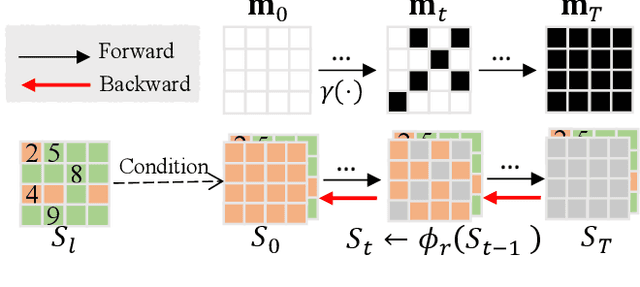
Abstract:Real-world image super-resolution (RWSR) is a long-standing problem as low-quality (LQ) images often have complex and unidentified degradations. Existing methods such as Generative Adversarial Networks (GANs) or continuous diffusion models present their own issues including GANs being difficult to train while continuous diffusion models requiring numerous inference steps. In this paper, we propose an Iterative Token Evaluation and Refinement (ITER) framework for RWSR, which utilizes a discrete diffusion model operating in the discrete token representation space, i.e., indexes of features extracted from a VQGAN codebook pre-trained with high-quality (HQ) images. We show that ITER is easier to train than GANs and more efficient than continuous diffusion models. Specifically, we divide RWSR into two sub-tasks, i.e., distortion removal and texture generation. Distortion removal involves simple HQ token prediction with LQ images, while texture generation uses a discrete diffusion model to iteratively refine the distortion removal output with a token refinement network. In particular, we propose to include a token evaluation network in the discrete diffusion process. It learns to evaluate which tokens are good restorations and helps to improve the iterative refinement results. Moreover, the evaluation network can first check status of the distortion removal output and then adaptively select total refinement steps needed, thereby maintaining a good balance between distortion removal and texture generation. Extensive experimental results show that ITER is easy to train and performs well within just 8 iterative steps. Our codes will be available publicly.
Enhancing Diffusion Models with Text-Encoder Reinforcement Learning
Nov 27, 2023
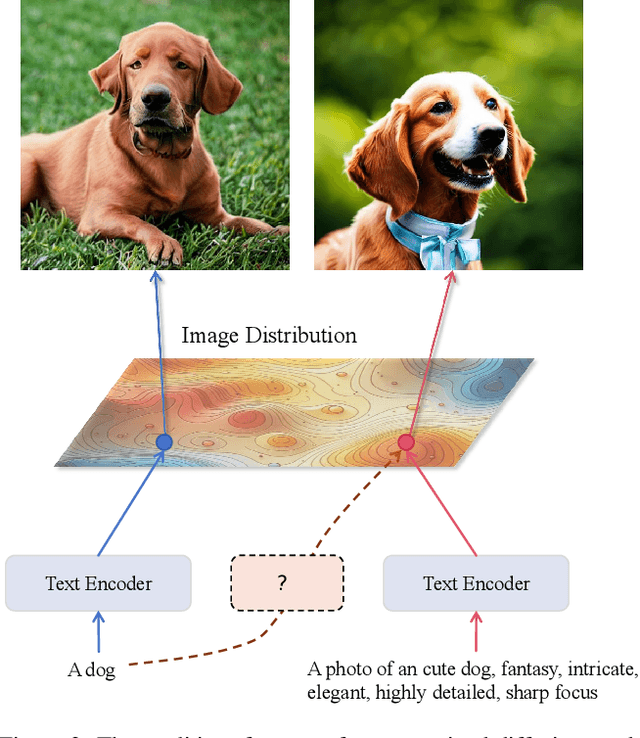
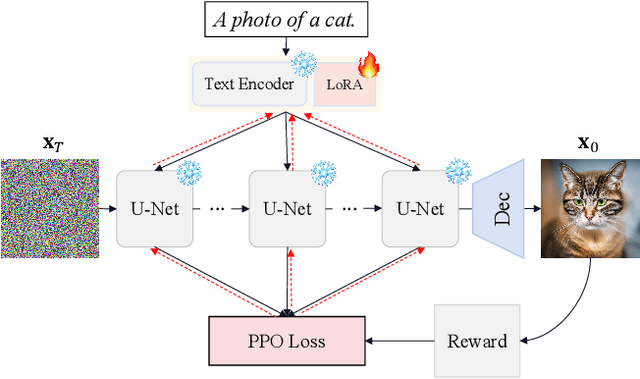

Abstract:Text-to-image diffusion models are typically trained to optimize the log-likelihood objective, which presents challenges in meeting specific requirements for downstream tasks, such as image aesthetics and image-text alignment. Recent research addresses this issue by refining the diffusion U-Net using human rewards through reinforcement learning or direct backpropagation. However, many of them overlook the importance of the text encoder, which is typically pretrained and fixed during training. In this paper, we demonstrate that by finetuning the text encoder through reinforcement learning, we can enhance the text-image alignment of the results, thereby improving the visual quality. Our primary motivation comes from the observation that the current text encoder is suboptimal, often requiring careful prompt adjustment. While fine-tuning the U-Net can partially improve performance, it remains suffering from the suboptimal text encoder. Therefore, we propose to use reinforcement learning with low-rank adaptation to finetune the text encoder based on task-specific rewards, referred as \textbf{TexForce}. We first show that finetuning the text encoder can improve the performance of diffusion models. Then, we illustrate that TexForce can be simply combined with existing U-Net finetuned models to get much better results without additional training. Finally, we showcase the adaptability of our method in diverse applications, including the generation of high-quality face and hand images.
Q-Instruct: Improving Low-level Visual Abilities for Multi-modality Foundation Models
Nov 12, 2023



Abstract:Multi-modality foundation models, as represented by GPT-4V, have brought a new paradigm for low-level visual perception and understanding tasks, that can respond to a broad range of natural human instructions in a model. While existing foundation models have shown exciting potentials on low-level visual tasks, their related abilities are still preliminary and need to be improved. In order to enhance these models, we conduct a large-scale subjective experiment collecting a vast number of real human feedbacks on low-level vision. Each feedback follows a pathway that starts with a detailed description on the low-level visual appearance (*e.g. clarity, color, brightness* of an image, and ends with an overall conclusion, with an average length of 45 words. The constructed **Q-Pathway** dataset includes 58K detailed human feedbacks on 18,973 images with diverse low-level appearance. Moreover, to enable foundation models to robustly respond to diverse types of questions, we design a GPT-participated conversion to process these feedbacks into diverse-format 200K instruction-response pairs. Experimental results indicate that the **Q-Instruct** consistently elevates low-level perception and understanding abilities across several foundational models. We anticipate that our datasets can pave the way for a future that general intelligence can perceive, understand low-level visual appearance and evaluate visual quality like a human. Our dataset, model zoo, and demo is published at: https://q-future.github.io/Q-Instruct.
 Add to Chrome
Add to Chrome Add to Firefox
Add to Firefox Add to Edge
Add to Edge